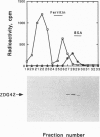Abstract
The Xenopus developmental gene DG42 is expressed during early embryonic development, between the midblastula and neurulation stages. The deduced protein sequence of Xenopus DG42 shows similarity to Rhizobium Nod C, Streptococcus Has A, and fungal chitin synthases. Previously, we found that the DG42 protein made in an in vitro transcription/translation system catalyzed synthesis of an array of chitin oligosaccharides. Here we show that cell extracts from early Xenopus and zebrafish embryos also synthesize chitooligosaccharides. cDNA fragments homologous to DG42 from zebrafish and mouse were also cloned and sequenced. Expression of these homologs was similar to that described for Xenopus based on Northern and Western blot analysis. The Xenopus anti-DG42 antibody recognized a 63-kDa protein in extracts from zebrafish embryos that followed a similar developmental expression pattern to that previously described for Xenopus. The chitin oligosaccharide synthase activity found in extracts was inactivated by a specific DG42 antibody; synthesis of hyaluronic acid (HA) was not affected under the conditions tested. Other experiments demonstrate that expression of DG42 under plasmid control in mouse 3T3 cells gives rise to chitooligosaccharide synthase activity without an increase in HA synthase level. A possible relationship between our results and those of other investigators, which show stimulation of HA synthesis by DG42 in mammalian cell culture systems, is provided by structural analyses to be published elsewhere that suggest that chitin oligosaccharides are present at the reducing ends of HA chains. Since in at least one vertebrate system hyaluronic acid formation can be inhibited by a pure chitinase, it seems possible that chitin oligosaccharides serve as primers for hyaluronic acid synthesis.
Full text
PDF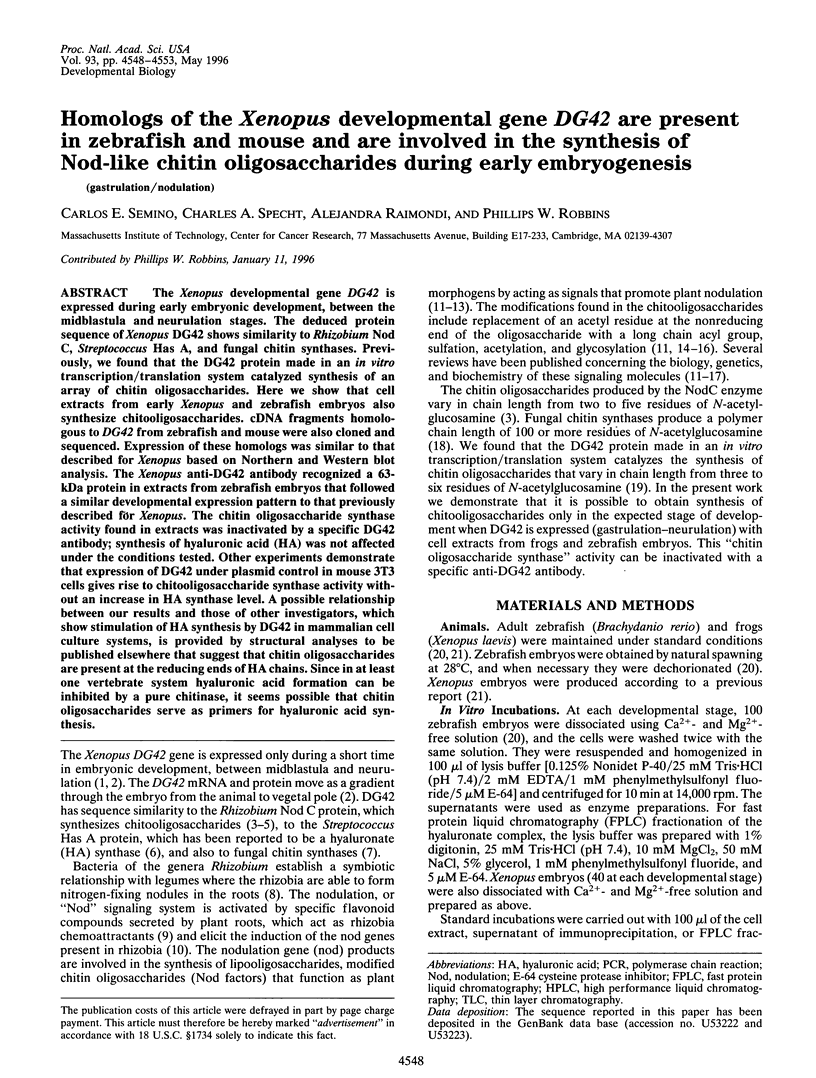
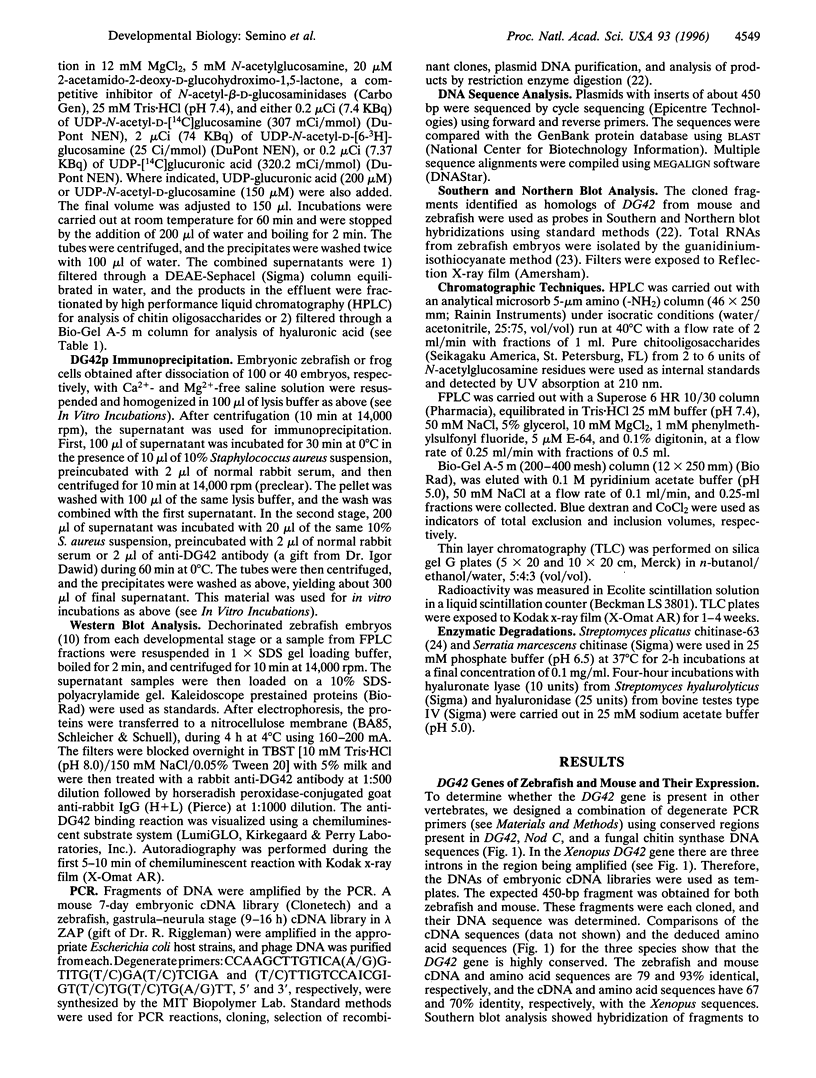
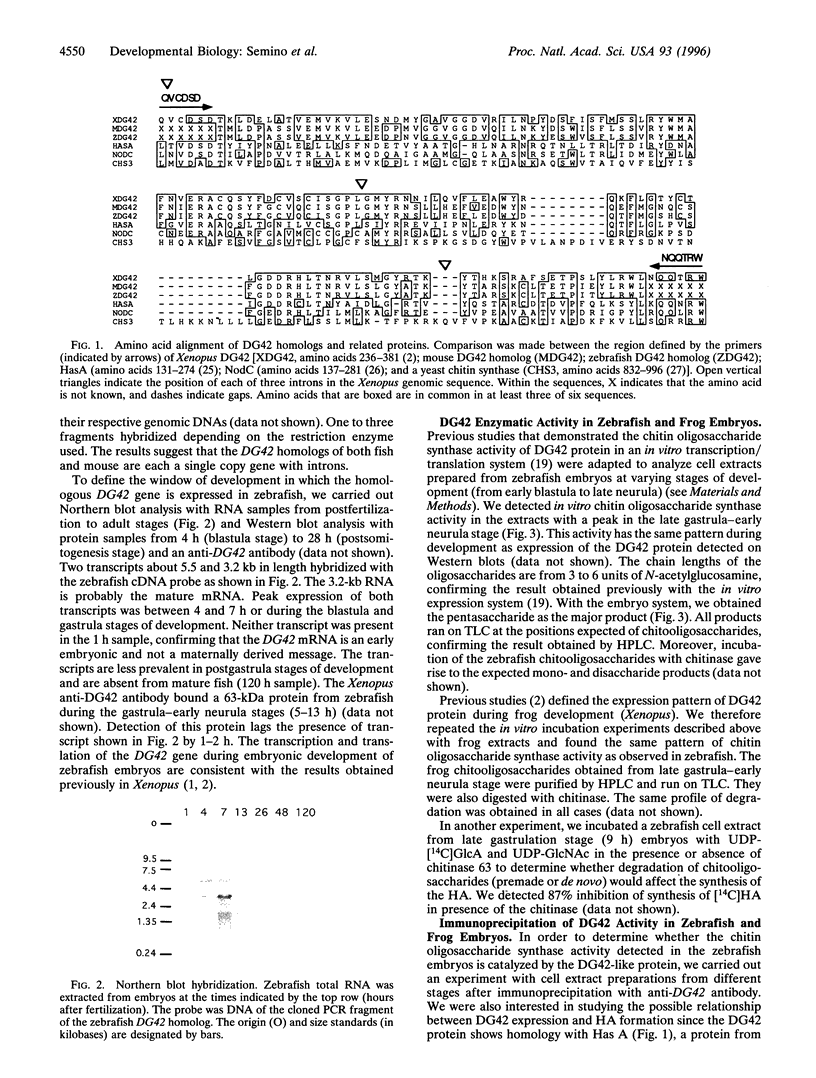
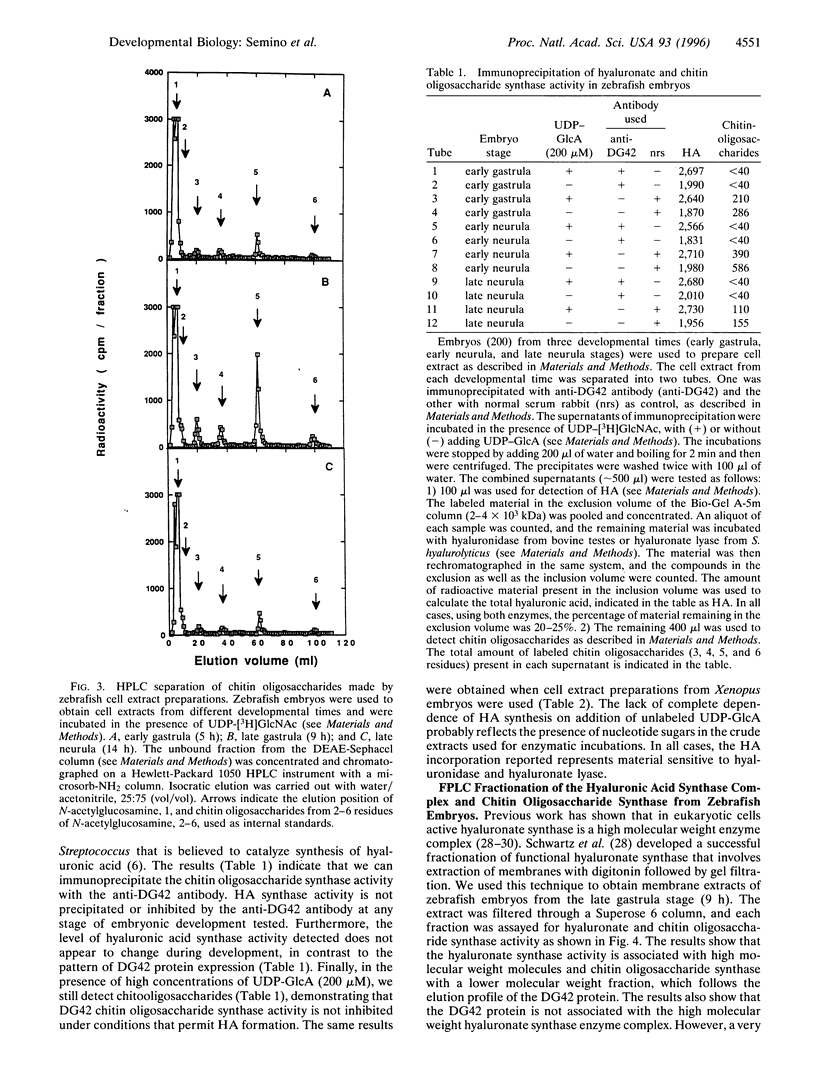
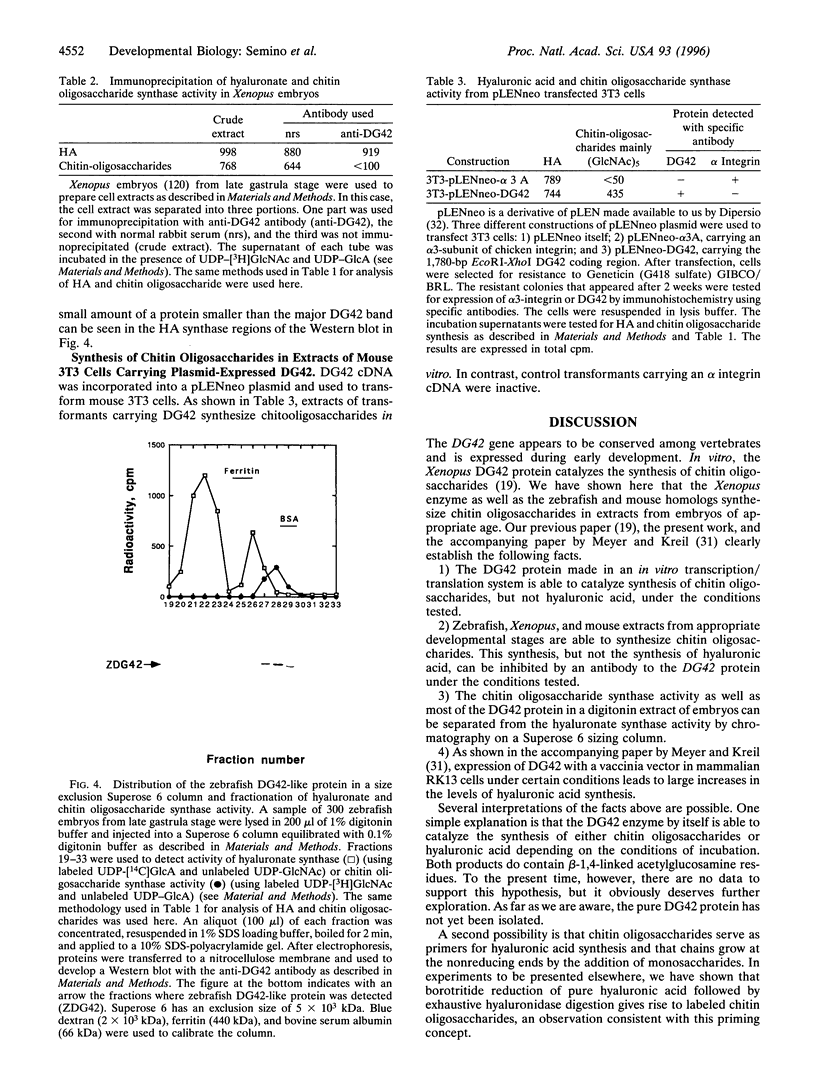
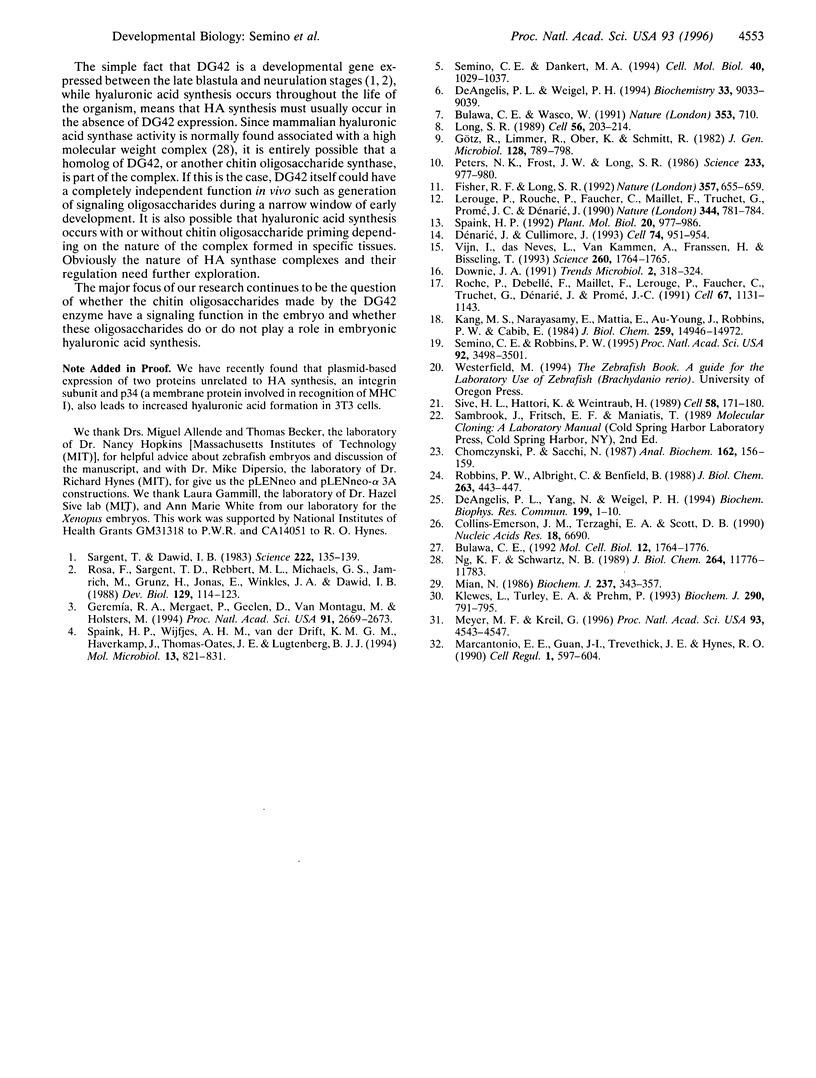
Images in this article
Selected References
These references are in PubMed. This may not be the complete list of references from this article.
- Bulawa C. E. CSD2, CSD3, and CSD4, genes required for chitin synthesis in Saccharomyces cerevisiae: the CSD2 gene product is related to chitin synthases and to developmentally regulated proteins in Rhizobium species and Xenopus laevis. Mol Cell Biol. 1992 Apr;12(4):1764–1776. doi: 10.1128/mcb.12.4.1764. [DOI] [PMC free article] [PubMed] [Google Scholar]
- Bulawa C. E., Wasco W. Chitin and nodulation. Nature. 1991 Oct 24;353(6346):710–710. doi: 10.1038/353710b0. [DOI] [PubMed] [Google Scholar]
- Chomczynski P., Sacchi N. Single-step method of RNA isolation by acid guanidinium thiocyanate-phenol-chloroform extraction. Anal Biochem. 1987 Apr;162(1):156–159. doi: 10.1006/abio.1987.9999. [DOI] [PubMed] [Google Scholar]
- Collins-Emerson J. M., Terzaghi E. A., Scott D. B. Nucleotide sequence of Rhizobium loti nodC. Nucleic Acids Res. 1990 Nov 25;18(22):6690–6690. doi: 10.1093/nar/18.22.6690. [DOI] [PMC free article] [PubMed] [Google Scholar]
- DeAngelis P. L., Weigel P. H. Immunochemical confirmation of the primary structure of streptococcal hyaluronan synthase and synthesis of high molecular weight product by the recombinant enzyme. Biochemistry. 1994 Aug 9;33(31):9033–9039. doi: 10.1021/bi00197a001. [DOI] [PubMed] [Google Scholar]
- DeAngelis P. L., Yang N., Weigel P. H. The Streptococcus pyogenes hyaluronan synthase: sequence comparison and conservation among various group A strains. Biochem Biophys Res Commun. 1994 Feb 28;199(1):1–10. doi: 10.1006/bbrc.1994.1184. [DOI] [PubMed] [Google Scholar]
- Downie J. A. Signalling strategies for nodulation of legumes by rhizobia. Trends Microbiol. 1994 Sep;2(9):318–324. doi: 10.1016/0966-842x(94)90448-0. [DOI] [PubMed] [Google Scholar]
- Dénarié J., Cullimore J. Lipo-oligosaccharide nodulation factors: a minireview new class of signaling molecules mediating recognition and morphogenesis. Cell. 1993 Sep 24;74(6):951–954. doi: 10.1016/0092-8674(93)90717-5. [DOI] [PubMed] [Google Scholar]
- Fisher R. F., Long S. R. Rhizobium--plant signal exchange. Nature. 1992 Jun 25;357(6380):655–660. doi: 10.1038/357655a0. [DOI] [PubMed] [Google Scholar]
- Geremia R. A., Mergaert P., Geelen D., Van Montagu M., Holsters M. The NodC protein of Azorhizobium caulinodans is an N-acetylglucosaminyltransferase. Proc Natl Acad Sci U S A. 1994 Mar 29;91(7):2669–2673. doi: 10.1073/pnas.91.7.2669. [DOI] [PMC free article] [PubMed] [Google Scholar]
- Kang M. S., Elango N., Mattia E., Au-Young J., Robbins P. W., Cabib E. Isolation of chitin synthetase from Saccharomyces cerevisiae. Purification of an enzyme by entrapment in the reaction product. J Biol Chem. 1984 Dec 10;259(23):14966–14972. [PubMed] [Google Scholar]
- Klewes L., Turley E. A., Prehm P. The hyaluronate synthase from a eukaryotic cell line. Biochem J. 1993 Mar 15;290(Pt 3):791–795. doi: 10.1042/bj2900791. [DOI] [PMC free article] [PubMed] [Google Scholar]
- Lerouge P., Roche P., Faucher C., Maillet F., Truchet G., Promé J. C., Dénarié J. Symbiotic host-specificity of Rhizobium meliloti is determined by a sulphated and acylated glucosamine oligosaccharide signal. Nature. 1990 Apr 19;344(6268):781–784. doi: 10.1038/344781a0. [DOI] [PubMed] [Google Scholar]
- Long S. R. Rhizobium-legume nodulation: life together in the underground. Cell. 1989 Jan 27;56(2):203–214. doi: 10.1016/0092-8674(89)90893-3. [DOI] [PubMed] [Google Scholar]
- Marcantonio E. E., Guan J. L., Trevithick J. E., Hynes R. O. Mapping of the functional determinants of the integrin beta 1 cytoplasmic domain by site-directed mutagenesis. Cell Regul. 1990 Jul;1(8):597–604. doi: 10.1091/mbc.1.8.597. [DOI] [PMC free article] [PubMed] [Google Scholar]
- Meyer M. F., Kreil G. Cells expressing the DG42 gene from early Xenopus embryos synthesize hyaluronan. Proc Natl Acad Sci U S A. 1996 May 14;93(10):4543–4547. doi: 10.1073/pnas.93.10.4543. [DOI] [PMC free article] [PubMed] [Google Scholar]
- Mian N. Characterization of a high-Mr plasma-membrane-bound protein and assessment of its role as a constituent of hyaluronate synthase complex. Biochem J. 1986 Jul 15;237(2):343–357. doi: 10.1042/bj2370343. [DOI] [PMC free article] [PubMed] [Google Scholar]
- Ng K. F., Schwartz N. B. Solubilization and partial purification of hyaluronate synthetase from oligodendroglioma cells. J Biol Chem. 1989 Jul 15;264(20):11776–11783. [PubMed] [Google Scholar]
- Peters N. K., Frost J. W., Long S. R. A plant flavone, luteolin, induces expression of Rhizobium meliloti nodulation genes. Science. 1986 Aug 29;233(4767):977–980. doi: 10.1126/science.3738520. [DOI] [PubMed] [Google Scholar]
- Robbins P. W., Albright C., Benfield B. Cloning and expression of a Streptomyces plicatus chitinase (chitinase-63) in Escherichia coli. J Biol Chem. 1988 Jan 5;263(1):443–447. [PubMed] [Google Scholar]
- Roche P., Debellé F., Maillet F., Lerouge P., Faucher C., Truchet G., Dénarié J., Promé J. C. Molecular basis of symbiotic host specificity in Rhizobium meliloti: nodH and nodPQ genes encode the sulfation of lipo-oligosaccharide signals. Cell. 1991 Dec 20;67(6):1131–1143. doi: 10.1016/0092-8674(91)90290-f. [DOI] [PubMed] [Google Scholar]
- Rosa F., Sargent T. D., Rebbert M. L., Michaels G. S., Jamrich M., Grunz H., Jonas E., Winkles J. A., Dawid I. B. Accumulation and decay of DG42 gene products follow a gradient pattern during Xenopus embryogenesis. Dev Biol. 1988 Sep;129(1):114–123. doi: 10.1016/0012-1606(88)90166-2. [DOI] [PubMed] [Google Scholar]
- Sargent T. D., Dawid I. B. Differential gene expression in the gastrula of Xenopus laevis. Science. 1983 Oct 14;222(4620):135–139. doi: 10.1126/science.6688681. [DOI] [PubMed] [Google Scholar]
- Semino C. E., Dankert M. A. The in vitro biosynthesis of functional nodulation factors (Nod Rm) produced by Rhizobium meliloti 1021. Cell Mol Biol (Noisy-le-grand) 1994 Nov;40(7):1029–1037. [PubMed] [Google Scholar]
- Semino C. E., Robbins P. W. Synthesis of "Nod"-like chitin oligosaccharides by the Xenopus developmental protein DG42. Proc Natl Acad Sci U S A. 1995 Apr 11;92(8):3498–3501. doi: 10.1073/pnas.92.8.3498. [DOI] [PMC free article] [PubMed] [Google Scholar]
- Sive H. L., Hattori K., Weintraub H. Progressive determination during formation of the anteroposterior axis in Xenopus laevis. Cell. 1989 Jul 14;58(1):171–180. doi: 10.1016/0092-8674(89)90413-3. [DOI] [PubMed] [Google Scholar]
- Spaink H. P. Rhizobial lipo-oligosaccharides: answers and questions. Plant Mol Biol. 1992 Dec;20(5):977–986. doi: 10.1007/BF00027167. [DOI] [PubMed] [Google Scholar]
- Spaink H. P., Wijfjes A. H., van der Drift K. M., Haverkamp J., Thomas-Oates J. E., Lugtenberg B. J. Structural identification of metabolites produced by the NodB and NodC proteins of Rhizobium leguminosarum. Mol Microbiol. 1994 Sep;13(5):821–831. doi: 10.1111/j.1365-2958.1994.tb00474.x. [DOI] [PubMed] [Google Scholar]
- Vijn I., das Nevas L., van Kammen A., Franssen H., Bisseling T. Nod factors and nodulation in plants. Science. 1993 Jun 18;260(5115):1764–1765. doi: 10.1126/science.8511583. [DOI] [PubMed] [Google Scholar]




